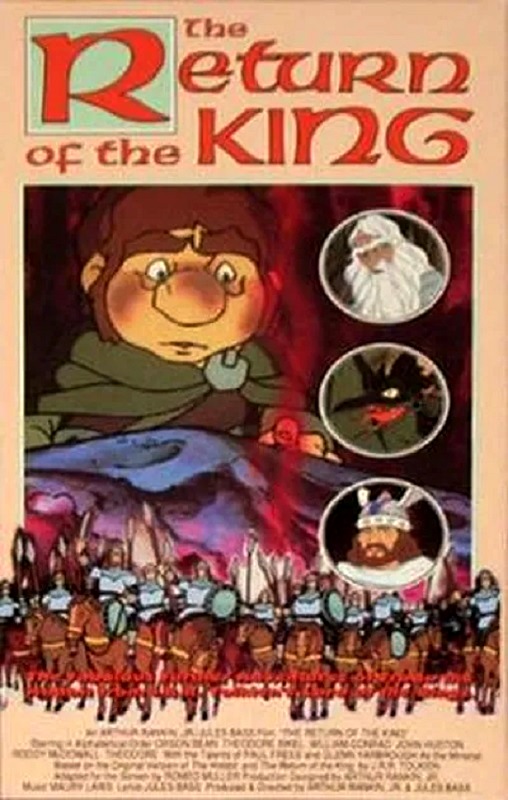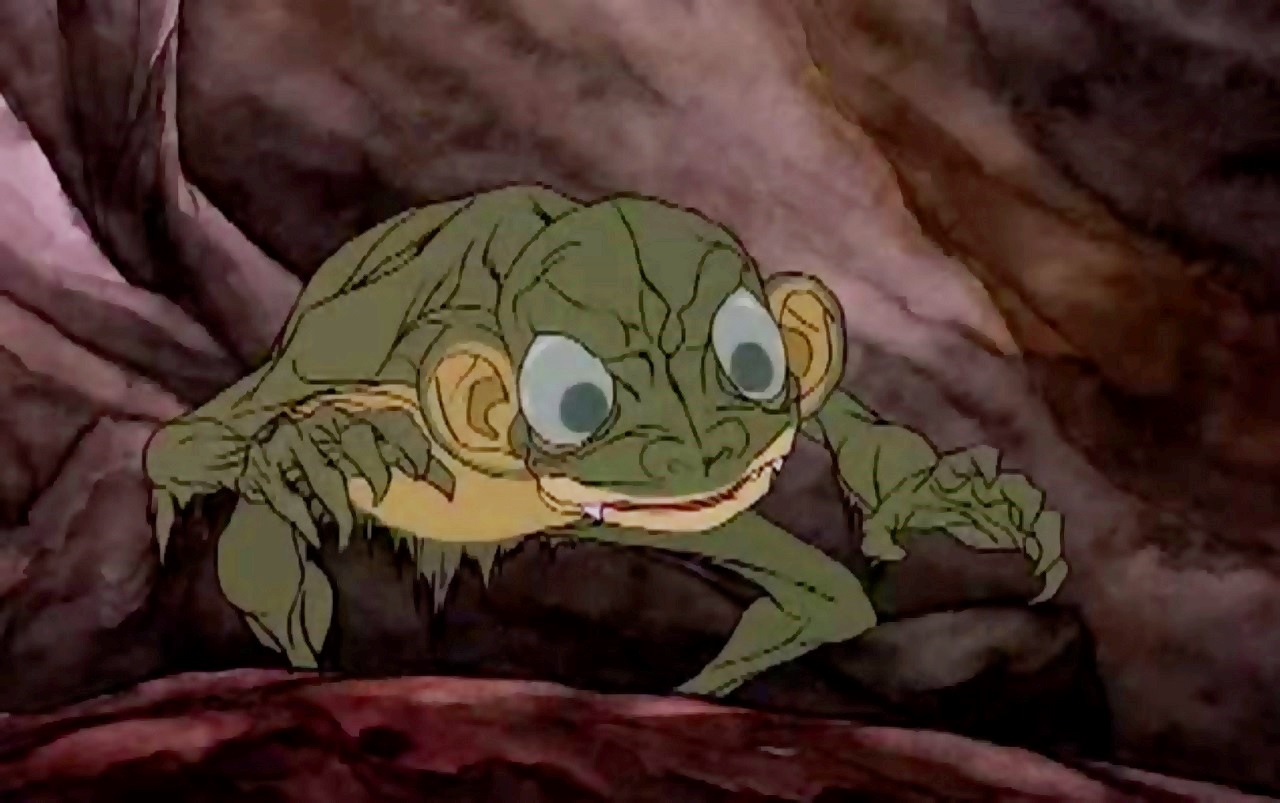
aka Frodo: The Hobbit II
USA. 1980.
Crew
Directors/Producers – Jules Bass & Arthur Rankin, Jr., Teleplay – Romeo Muller, Based on the Novel by J.R.R. Tolkien, Music – Jules Bass & Maury Laws, Animation Directors – Koichi Sasaki & Katsuhisa Yamada,, Production Design – Arthur Rankin, Jr.. Production Company – Rankin-Bass Productions, Inc..
Voices
Roddy McDowall (Samwise Gamgee), Orson Bean (Frodo Baggins/Bilbo Baggins), John Huston (Gandalf), Theodore [Gottlieb] (Gollum), Theodore Bikel (Aragorn), Casey Kasem (Merry Brandybuck), Sonny Melendez (Pippin Took), William Conrad (Lord Denethor), Don Messick (King Theoden/The Mouth of Sauron), Nellie Bellflower (Eowyn), Paul Frees (Elrond/Captain Shagrat/Lieutenant Snaga/Orc/Goblin/Uruk-Hai), Glenn Yarbrough (The Minstrel)
Plot
While on his quest to take the One Ring to Mordor, Frodo Baggins has been captured by orcs. Samwise Gamgee finds the dropped ring and uses its power of invisibility to affect Frodo’s escape. With Frodo weakened, the two struggle onwards towards Mordor, trying to avoid the orcs. Meanwhile, Sauron’s orc armies approach Minis Tirith where Gandalf rallies the people of the city to defend against their overwhelming numbers.
Way back before Peter Jackson took the world over with his trilogy of J.R.R. Tolkien adaptations – The Lord of the Rings: The Fellowship of the Ring (2001), The Lord of the Rings: The Two Towers (2002) and The Lord of the Rings: The Return of the King (2003) – and then blew out with his trilogy of prequel films – The Hobbit: An Unexpected Journey (2012), The Hobbit: The Desolation of Smaug (2013) and The Hobbit: The Battle of the Five Armies (2014) – later to be followed by Jackson-less tv series The Lord of the Rings: The Rings of Power (2022- ) and the Jackson produced anime film The Lord of the Rings: The War of the Rohirrim (2024) – there was another whole largely forgotten era of Tolkien screen adaptations.
This other era of Tolkien on screen began with the tv movie The Hobbit (1977) from Jules Bass and Arthur Rankin, Jr. who between them ran the Rankin-Bass animation studio. (See below for Rankin-Bass’s other films). Although generally disparaged, their version of The Hobbit was a far more faithful adaptation of the book than Jackson’s bloated trilogy ended up being. Ralph Bakshi then announced his ambitious animated theatrically-released adaptation of the trilogy, which he had intended to be split into two parts, beginning with The Lord of the Rings (1978). However, due to poor box-office performance of the film, the second part was never made. Bakshi made a deal and turned what would have been the second half over to Rankin-Bass who mounted The Return of the King as a sequel of sorts to The Hobbit – it was actually called Frodo: The Hobbit II in some parts.
While Rankin-Bass’s The Hobbit is generally tolerated, The Return of the King has a bad rap. Coming to it after having read some of this, I found it somewhat better than I expected it to be. Scriptwriter Romeo Muller has certainly read the books and gets all the places, character names and pieces of mythology down pat for the most part – the film has a flavour of Tolkien even if some of the plotting is all over the place.
Certainly, as a standalone work, The Return of the King is impossible to follow if one has not read The Lord of the Rings – it makes little sense when seen as a sequel to Rankin-Bass’s The Hobbit either. Rankin-Bass try to compensate by throwing in pieces of backstory that fill out the rest of the saga but are dealing with such a vast canvas that such is almost impossible. The story here, for example, opens with Frodo a prisoner of the orcs at Cirith Ungol where the entire backstory about the quest to Mordor and the forming of the fellowship is condensed to a handful of flashback scenes.

On the plus side, the story is more faithful to much of The Return of the King than Jackson was in many ways. It is certainly more of a Frodo and in particular a Samwise story that Jackson ever made it and retains many of the pieces of adventure that Jackson skipped over. On the other hand, the siege of Minas Tirith is lessened. The Fellowship are largely sidelined – Merry, Pippin and Gandalf are present but Legolas and Gimli have been eliminated, while Aragorn only makes an appearance at the end in order to make the title come true. Like Jackson, the film ends with the departure of the elves and omits the return to the shire and the eviction of Saruman.
The animation is fairly good compared to the other works that Rankin-Bass were putting out around this time with the battle scenes emerging quite impressively. The film has a much darker and more turbulent feel than the work they did on The Hobbit. Although you suspect if Ralph Bakshi were able to jump on board with the quality of animation he did on The Lord of the Rings, The Return of the King would have emerged as a much better film.
On the minus side, The Return of the King also retains one of the worst parts about Rankin-Bass’s The Hobbit – the folk songs on the soundtrack. While you could kind of argue that that is keeping in spirit with Tolkien, who had a good many songs and poems peppered throughout the book, it is something that very much dates the film and drags scenes out. We even get singing orcs at one point.
Jules/Julie Bass and Arthur Rankin Jr had made a number of other animated and stop-motion animated works for children. They started out with Rankin merely writing his name as director-producer on the English-language versions of Japanese films like Willy McBean and His Magic Machine (1965) and King Kong Escapes (1967). They went onto make the delightful stop-motion animated Mad Monster Party? (1967) and the various Frosty the Snowman and Rudolph the Red-Nosed Reindeer tv specials, among other seasonal tv productions. By the late 1970s, Rankin and Bass made several animated films with The Flight of Dragons (1982) and the excellent The Last Unicorn (1982). The company went into decline in the late 1980s, before its dissolution in 2001.
Fan-edited trailer here